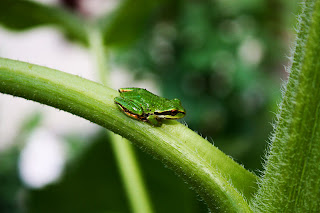Silent Spring
 |
| Pacific Chorus Frog (Pseudacris regilla) |
"There was once a town in the heart of America where all life seemed to live in harmony with its surroundings."I was in high school when Silent Spring was published. It was a sensation. It became THE book to read. President Kennedy mentioned it in a press conference. Despite the howling of the chemical industry, the President's Science Advisory Committee confirmed Rachel Carson's findings. Human activity can have a profound impact on nature. The book literally changed history, and created a lasting public awareness of nature and the environment. Those were the days when decisions were based on science, data and evidence, not politics, big money or special interests.
"Then a strange blight crept over the area and everything began to change. Some evil spell had settled on the community;"
"There was a strange stillness. ...there was now no sound; only silence lay over the fields and woods and marsh."
-Rachel Carson, Silent Spring, 1962
Silent Spring seems to have come to South Fidalgo Island and it is scarring me to death.
In 1999, I installed a koi pond as a part of the entry garden. It sits below my second floor bedroom window. For two years, I had beautiful koi that had even produced young. Between the River Otters and Great Blue Herons, however, the koi were not destined to be a lasting feature in my garden. Last year, I stocked the pond with eleven Shubunkin goldfish and provided features for hiding and escape from predators. Nevertheless, thanks to the herons, they didn't last two weeks. Coming out of my front door, I encountered a heron standing in the pond. Needless to say, we were both startled out of our wits at the confrontation.
While the fish were not a successful venture, the Pacific Chorus Frogs (Pseudacris regilla) a.k.a. Pacific Tree Frogs became reliable and welcome seasonal visitors to the pond. They are the official state amphibians of Washington. These tiny, secretive creatures have huge voices. Domingo and Carreras would be impressed. For eleven concert seasons they came. Their festivals would begin every March, just a few voices at first. The early arrivers seemed to be announcing the discovery of a suitable breeding pond to call in the others. I came to recognize that individuals had different voices, mostly low tenors and baritones, and they sang different songs.
By April their numbers would swell to a few dozen. These choirs produced truly magnificent concerts through the night. The first year, I was concerned I would be kept awake by the noise. Instead, I was happily sung to sleep by these nightly musicales. I came to look forward to their arrival. It's actually the boys that are singing to attract the girls. It seems to work. At the peak of the season, shine a light on the scene. You will blush at the sight of frenzy and singing and chasing and desperation and total oblivion to your presence.
But not this year. This has been a silent spring at the koi pond.
In a previous post, I noted that the frogs seemed to be late this year. I attributed this to our cold La Niña weather. Weather-wise, March and April were more like December and November around here. But now it's May, the frogs have still not shown up, and it's not just my koi pond. There is a small wetland across the road and I hear no frogs up there either.
The Pacific Chorus Frogs only come to water to breed. By June, they leave the pond and spend the rest of the year making their living on dry land. The tiny froglets grown from the season's tadpoles may be seen sunning themselves on plants around the pond. By mid-summer, they have also moved on. Occasionally, I will encounter a frog in the garden, but they are very hard to spot. In the middle of winter, they will sometimes come out to sing during the day. A long, slow, raspy krrrrrreck will be heard from their vegetation cover. I did hear them this past winter making their absence now even more puzzling.
I am not prepared to speculate why there are no frogs this year, but I am alarmed. It is still possible that the cold weather has delayed them. I hope this is the case and they will be arriving shortly. Amphibians are considered to be indicator species, like the canary in the coal mine. Their skin is semi-permeable allowing toxins and gases from water and the air to pass through. They are sensitive to both pollution and climate change, and can be harmed by excessive ultraviolet radiation. The disappearance of frogs world-wide has been documented. A few causes have been determined but overall, this disappearance is not very well understood. This lack of understanding makes my silent spring even creepier. The frogs are trying to tell us something, but we can't hear what they are saying.
"It took hundreds of millions of years to produce the life that now inhabits the earth--eons of time in which that developing and evolving and diversifying life reached a state of adjustment and balance with its surroundings."
"The rapidity of change and the speed with which new situations are created follow the impetuous and heedless pace of man rather than the deliberate pace of nature."
-Rachel Carson
"Man did not weave this web of life, he is merely a strand in it. Whatever he does to the web, he does to himself. "Photo: Kjfmartin via Wikimedia Commons
-Chief Seattle
Weather Statistics for April, 2011
| Temperature | High 61.6° F | Low 35.3° F | Mean 45.3° F |
| Rainfall | 2.48 inches | ||
| Wind | High 33 mph | Average 2.1 mph | Dom Dir SW |
Observed at South Fidalgo Island (See Climate page for complete climatological data)